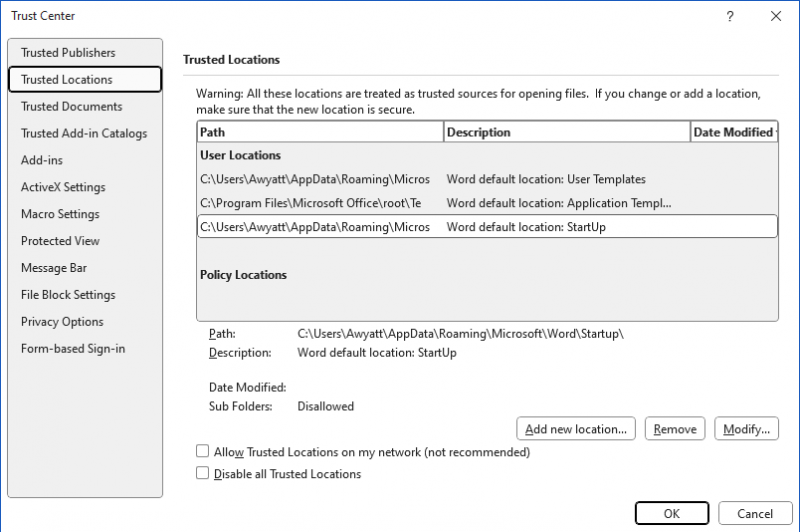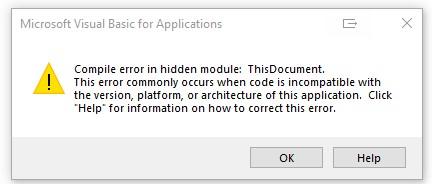Written by Allen Wyatt (last updated October 12, 2024)
This tip applies to Word 2007, 2010, 2013, 2016, 2019, 2021, and Word in Microsoft 365
Michael has a set of macros that copy selected content from one open document to another open document. He's put these macros in a template in an attempt at portability, but they don't seem to be available within documents based on the template. Michael wonders if there is a way—short of putting them in the Normal template—to make these macros available to other open documents.
The traditional way to do this is to create your own template, which means that you save it using the DOTM extension. (Simply save the file as a macro-enabled template. This sets the extension properly.) Make sure that the template includes all of the macros that you want to universally access. (It should not contain macros that you want to keep in your Normal template, instead.)
When your template is set up and saved just the way you want it, follow these steps:

Figure 1. The Trusted Locations area of the Trust Center.
With the full path name in hand (step 6) you can get out of Word. You want, at this point, to locate the template you created earlier and copy it to the folder specified by the path name. It is in this folder (the Startup folder) that you place documents you want automatically loaded whenever you start Word. By placing the template there, you are assured that it will be opened when you start Word, and that the macros it contains will be available during your Word session.
You should note that the folder you discovered through the above steps (the one shown in step 6) is probably a hidden folder on your system. This may make it a bit tricky to track down, but you can search on my WindowsTips site (windows.tips.net) to find out how to display and use hidden folders.
There is one potential "gotcha" here: When you place the template in the Startup folder, the macros in the template can be run, but they cannot be directly edited. If you need to make changes to them (or add other macros to the template), you'll want to get out of Word and, within Windows, move the template out of the Startup folder. You can then load the template directly and make changes you desire. Then, save the template and again get out of Word. Finally, use Windows to move the template back to the Startup folder.
Note that once your template is fairly stable (the template you stored in the Startup folder), you can share that template with others and invite them to store it in their own Startup folder. You'll need to give them directions, of course, on how to do that storing, as noted above.
Note:
WordTips is your source for cost-effective Microsoft Word training. (Microsoft Word is the most popular word processing software in the world.) This tip (4632) applies to Microsoft Word 2007, 2010, 2013, 2016, 2019, 2021, and Word in Microsoft 365.

Do More in Less Time! An easy-to-understand guide to the more advanced features available in the Microsoft 365 version of Word. Enhance the quality of your documents and boost productivity in any field with this in-depth resource. Complete your Word-related tasks more efficiently as you unlock lesser-known tools and learn to quickly access the features you need. Check out Microsoft 365 Word For Professionals For Dummies today!
You can open multiple documents at the same time in Word, and each document occupies its own document window. Here's a ...
Discover MoreOne of the most common ways of creating macros is to use Word's macro recorder. This tip shows how easy it is to use the ...
Discover MoreMacros are often used to process documents, resulting in changes of one manner or another. If you need your macro to add ...
Discover MoreFREE SERVICE: Get tips like this every week in WordTips, a free productivity newsletter. Enter your address and click "Subscribe."
2024-10-14 06:23:17
Sarah Patey
(see Figure 1 below)
I have a macro (one of Paul Beverley's) that enables me to call up the dialog to assign a keyboard shortcut. I went through this process and got the message above.
Would I need to assign my shortcuts in the DOTM file when I create it, and before moving it to the startup folder?

Figure 1.
Got a version of Word that uses the ribbon interface (Word 2007 or later)? This site is for you! If you use an earlier version of Word, visit our WordTips site focusing on the menu interface.
Visit the WordTips channel on YouTube
FREE SERVICE: Get tips like this every week in WordTips, a free productivity newsletter. Enter your address and click "Subscribe."
Copyright © 2026 Sharon Parq Associates, Inc.
Comments